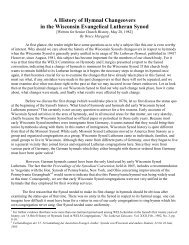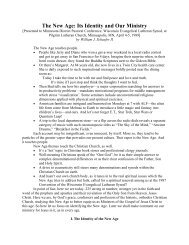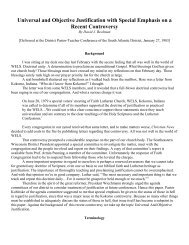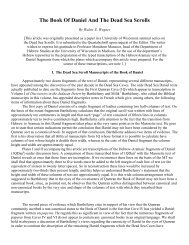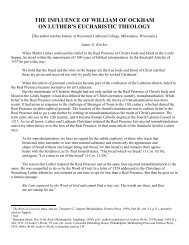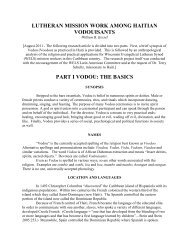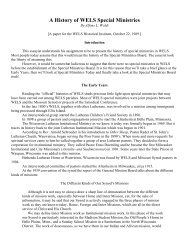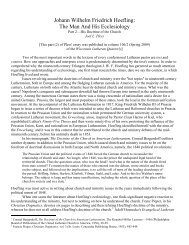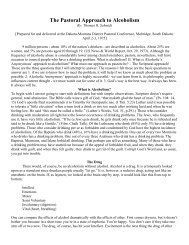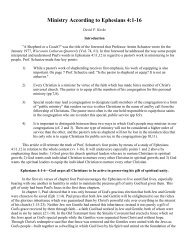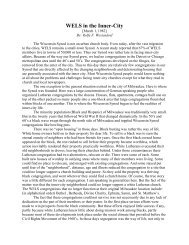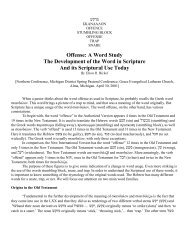Strangers to Sisters - Wisconsin Lutheran Seminary Library: Essays
Strangers to Sisters - Wisconsin Lutheran Seminary Library: Essays
Strangers to Sisters - Wisconsin Lutheran Seminary Library: Essays
You also want an ePaper? Increase the reach of your titles
YUMPU automatically turns print PDFs into web optimized ePapers that Google loves.
constitution, the reference <strong>to</strong> the <strong>Lutheran</strong> Confessions was crossed out and the words,<br />
“pure, Bible Christianity” and “pure, Bible Word” were written above it. 5<br />
Only in the subsequent years, after the arrival of confessionally-minded men like<br />
John Bading, Adolph Hoenecke, and Philip Koehler in the <strong>Wisconsin</strong> Synod; C.J.<br />
Albrecht and John Henry Sieker in the Minnesota Synod; Chris<strong>to</strong>pher Eberhardt and<br />
Stephen Klingmann in the Michigan Synod; did these synods make their long, hard turn<br />
<strong>to</strong>ward a confessional <strong>Lutheran</strong> position. By the late 1860s, the <strong>Wisconsin</strong> Synod had cut<br />
ties with the unionistic mission societies of Germany which had funded much of her early<br />
work. Also, both Minnesota and <strong>Wisconsin</strong> had removed themselves from the General<br />
Council for doctrinal reasons (Michigan would leave the General Council in the 1880s,<br />
also for confessional reasons). By 1868, fellowship with the Missouri Synod was<br />
established, and by 1872, the <strong>Wisconsin</strong> and Minnesota Synods were two of the<br />
constituting members of the original Synodical Conference.<br />
In the years leading up <strong>to</strong> the <strong>Wisconsin</strong> merger of 1917, the three synods had<br />
been organized in<strong>to</strong> a federation. Oddly enough, the federation had been the thrust of the<br />
smaller Minnesota and the Michigan Synods, approaching the larger and geographically<br />
central <strong>Wisconsin</strong> Synod about pooling their resources for worker training. The years of<br />
federation allowed the synods <strong>to</strong> get <strong>to</strong> know each other. Once initial mistrust and<br />
misgivings were settled, it became clear that duplicating efforts was not the best use of<br />
resources. Thus the path for merger was set. With the exception of an argument over the<br />
status of Michigan <strong>Lutheran</strong> <strong>Seminary</strong>, the merger went through smoothly, resulting in<br />
what is <strong>to</strong>day the third largest <strong>Lutheran</strong> church body in America.<br />
5 John Braun. Together in Christ: A His<strong>to</strong>ry of the <strong>Wisconsin</strong> Evangelical <strong>Lutheran</strong> Synod (Milwaukee;<br />
Northwestern Publishing House, 2000), 5.<br />
7



